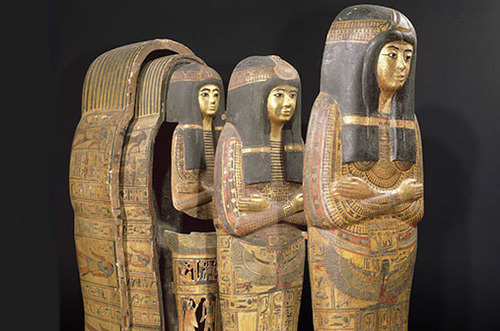According to Anders Bettum, Egyptologist at the Department of Culture Studies and Oriental Languages, University of Oslo (his PhD thesis, “Faces within Faces – The Symbolic Function of Nested Yellow Coffins in Ancient Egypt”), nested coffins were not only a status symbol for the Egyptian elite. “They also played a key role in the process that would link the deceased to their ancestors: to Osiris, the god of the afterlife, and to Amun-Ra, the sun- and creator god”.
The rituals and the myths that were reiterated during the seventy days that a funeral lasted are symbolically rendered on the coffins. The components of each nest, including the mummy-cover, the inner and outer coffins – reflect the Egyptians’ view of the world.
“The decorations, the forms and the choice of materials signify a unification of the two myths about Osiris and Amun-Ra respectively. On the outer coffin, the deceased is portrayed as Osiris, with a mummified body, a blue-striped wig and a pale, solemn face. The coffin is painted yellow and varnished, and must have shone like gold. The very richest Egyptians did in fact use gold leaf on their coffins. The choice of color is not coincidental: it represents the light and its origin in the sun. That the figure of Osiris is being bathed in sunlight can, in my mind, only mean one thing. The decoration invokes a well known mythical image: when the sun god arrives in the throne hall of Osiris in the 6th hour of the night and the two deities join in mystical union. According to the Egyptians, this union was the source of all regeneration in nature, and it was here, at the center of this ‘catalyst of life’ that the deceased wanted to be placed for all eternity.”Another key finding, Bettum explains, is that the innermost layers of the coffin nests dating from the 19th dynasty (approximately 1292-1191 BCE) were fashioned as living humans in their best outfits. The innermost layer was the most important one, since it shows the objective of the afterlife transformation: the “state of paradise” to which these people aspired involved not only a mystical union with the gods; but more importantly a return to their old “self”.
Even though complete Egyptian coffin nests still can be found intact in some places, most have been disassembled and are today scattered in museums all over the world. As a researcher, Bettum would like to see more international cooperation to reassemble the coffin ensembles in the same location. He also believes that such projects would be fascinating to the public and rekindle interest in some of the world’s largest and most enigmatic cultural treasures. “So far, national legislation and interests have unfortunately served as barriers to such cooperation,” he concludes.
Read more.

No comments:
Post a Comment